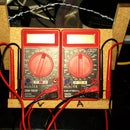Introduction: Save $500! Make Your Own Vertical Hydroponics/aquaponics System!
Looking online I've been intrigued by the vertical grow towers that people sell. They allow you to easily grow your own healthy, organic produce and take only very, very small amount of space. Unfortunately they cost upward of $500 bucks!
So I decided to create my own good quality vertical grow system with some great improvements over what's available. Best of all you can get everything you need from the local hardware store for about $50 -- that's 1/10th the cost of the commercial systems! In fact, I'll not only go for the win, but double-down. For my system you get TWO towers for that price!
This can also be found on my projects blog, here:
https://theheadlesssourceman.wordpress.com/2014/12/19/save-500-make-your-own-vertical-hydroponics-aquaponics-system/
Step 1: Materials and Tools
For materials you need:
- 10foot length of 4inch corrugated drain pipe.
- large sack of pearlite
- 12v power adapter
- large plastic tote
- roll of plastic sprinkler pipe
- hose clamp
- 12v pump
- roll plastic cling wrap
- (optional) barbed sprinkler fittings
- (optional) gravel
- (optional) old window screen and zip ties
For tools:
- scissors
- utility knife
- screwdriver
- basic soldering equipment
- drill and large bit
- (optional) heat gun
Step 2: The Drain Pipes
If you want to be able to use this for aquaponics (fish) in the future, you'll need to cover the bottom of the towers with screen so that the grow media does not come out. I just used zip ties to hold the screen on. The one half came with a coupler fitting that helped the zip tie to stay on. For the other side I poked a bamboo skewer through so that the zip-tie and screen wouldn't slide off the end. Or you could drill holes and zip through them.
Finally, drill some holes for the plants. Remember that the towers are going to go into the totes so start the plant holes a little up from the bottom - about 18 inches. The holes/pattern you choose will depend on what things you'll want to grow. Either way, probably best to do 3 pants to a layer and offset each layer by half a hole for maximum use of space.
We chose two different patterns. The one tower was 1 1/2 inch holes 6 inches apart for thick-stemmed things like lettuce. The other was 3/4 inch holes 3 inches apart for thin-stemmed plants like strawberries. Also, if possible use a hole saw rather than a spade bit for drilling these holes.
For drawing lines along the length of a pipe, use any straight piece of angled metal, plastic, etc. Just as long as it's STRAIGHT, it should automatically make itsself parallel to the pipe! For marking the holes around, make a template for 1/3 of the circumference of the pipe. (Not pictured. If I find where it went, I'll add a pic to this step.Found it!)
Step 3: The Container
It can be tricky to determine where to cut the holes in the lid for the towers because nearly every surface is sloped. The best way I found was to hold a square on the bottom corner and measure out to the edge of the rim. Then snap the lid on and measure from the outside of the rim to the outside of the lid. Then on the top of the lid, measure back in the sum of those last two measurements, plus a little for margin-of-error sake. Just trace around the pipe and cut it out, praying all the while that you didn't miss something.
Step 4: Pump and Power
1) Head. (in feet)
That means how high that pump can push water.
2) Flow rate. (in gallons per hour)
That means how much water it can deliver.
The two are inter-related. Obviously it takes more energy to push water up higher so that means you'll get less flow from the same pump. Get it? Fortunately almost all pumps have listed on the back of the package what flow rate you get for each head height.
For many peoples' hydroponics systems they go with fountain pumps. Those are not only expensive little buggars, but also run off AC wall power. What I discovered is that bilge pumps for boats are only about $15 and run off 12v -- so your system can be easily converted to solar power! The Attwood Tsunami pump I chose also has the added advantage that you can clean it out or even replace the motor without disconnecting any of the plumbing!
Just as a side note, if you want to go the whole way and get solar hooked up, check out this instructible:
https://www.instructables.com/id/Automatic-Solar-Powered-Greenhouse-Watering-System/
Until you get solar running, you'll need to find and wire up a 12v dc wall-wart power adapter (about 1.0a). You could keep it simple or add goodies like:
- An on/off switch.
- A potentiometer to control water flow rate.
- A connector for swapping pumps and experimenting with solar.
- A fuse would probably be a good idea as well.
Step 5: Sprinkler Pipe
During this phase I had amazing case of the cheapies, so I scored each corner lightly and used a heat gun and pliers to do the bends rather than buy barbed elbows. Also I capped the end with a carved-down chunk of wood. That's probably a little overboard. Regular barb fittings would probably be easier and better.
That being said, my cheapness did lead to one worthwhile innovation. For valves to control the flow to each tower, simply drill a 1/4 inch hole in the sprinkler pipe. Then cut off two one-inch pieces and slice them lengthwise. These clip over the other pipe and you simply turn them to regulate the water flow.
Step 6: Filling the Towers
Remember, with aquaponics, reactive surface area is everything. The basic science on that is you need plenty of surface area for microbes to convert ammonia and ammonium to nitrate and nitrite for your plants to grow. Pearlite, being a super-porous material is much, much better for this than, say, something like gravel. Sometimes things like cocoanut husk is used, but unlike pearlite (which is a type of rock), cocoanut husk will eventually decompose.
To minimize mess, wrap the towers in cling wrap. The pearlite won't fall out of the holes once its compacted and wet but right out of the bag it goes everywhere.
The light weight of the pearlite contributes to the stability of the grow towers. To help even more its a good idea to fill the bottom of the towers (up to about the height of the container) with regular gravel. Keeping the weight low is the key to stability.
By the way, be careful where you buy your pearlite. The stuff I got from HomeDepot had not only large chunks but bits way down to the size of dust. That might be fine for mixing with potting soil, but for this it won't let the water drain through and you'll get an overflow. I learned this the hard way, followed by the fun of many hours of sifting to get the fine stuff out. NOT COOL!
Even after all that we had a problem with water wanting to squirt out the holes and onto the floor rather than stay inside. After some experimentaion we discovered that you can easily fix this by taking a bamboo skewer or thin length ow dowel and poking it in+down inside each offending hole. What that does is direct water away from the holes and down the center of the pipe. Since we learned that trick all the water mess ended!
Step 7: Timer
To do that, simply find a 24 hour mechanical lamp timer, take it apart, and remove the last gear-reduction stage.
Here's how to do that:
(Don't get too hung up on the brand. As you can see mine was a Stanley brand but the procedure was identical.)
http://hackaday.com/2011/09/09/repeat-timer-hacked-for-35-minute-hydroponic-cycles/
The nice thing about the Stanley over the one in the video is that it has two outlets.
I plugged the pump into one side and a led light into the other so I could tell when it was on.
Step 8: Plant It Up
Start some seeds and gently transplant them into the tower holes.
You'll also need a start of nutrients in your water. A good organic mix like Neptune's Harvest is ideal for this. We went with a brand called Alaska... *something* from Home Depot. Either way, lets face it, it's basically a jug of half-rotted fish entrails. And smells like it! Seriously, horrifying! (The cats liked it though.)
After some experimentation, we discovered that the plants like about 1 tablespoon of the fish guts every 2-3 weeks.
And don't worry, that small amount doesn't stink up your house. You can smell it a little if you stick your nose right over the towers with the water on, but that's about it.
Step 9: It Works!
Anyway, now the plants are getting large and looking great!
Step 10: Epilogue:
I have finally retired this hydroponics system and thought I should give an update.
It worked, and I really liked the plant density that the vertical orientation provided, however...
The following were a constant problem:
4) Leakage. Since the holes are parallel to the trunk water and perlite can spill out. This could be mitigated by using cups of some sort, and the bottom tray does an okay job of catching water. We kept it wrapped in the cling wrap which helped as well. But...
3) Root wandering. Due to the presence of water, roots wandered outside the holes and down the surface of the tubes. Not a big problem, but kind of ugly and weird.
2) Caretaking. This requires both power to operate and constant refilling with water. Since we live in such a dry climate, we gave up on the pump entirely and simply poured in the refill water from the top.
1) Compaction. This was the biggest problem! The perlite compacted over time until it inhibited water flow. (Need to fill veeery sloooowly or it overflows.) Also, it made leakage much worse to the point of unmaneageable. Imagine, you pour in water, a bunch comes over the top, and the rest leaks out the top few holes while the bottom plants are dying of thirst.
Many of these are inherent to vertical design, for instance the system will always consume a lot of energy to return water to the top.
Since this time I've tried other experiments with raingutters arranged in vertical rows like a ladder. While this had issues as well, they were trivial in comparison. (Items 1 and 3 completely eliminated, 2 greatly reduced since water doesn't shoot straight down, and 4 still a problem due only to a stupid design mistake on my part)
LESSON LEARNED:
Horizontal rows beat vertical towers HANDS DOWN when it comes to vertical farming!
NOTE:
If you're still sold on vertical towers, at least use a non-compactable medium like zip-grow towers do.

Finalist in the
Hydroponics and Indoor Gardening Contest











